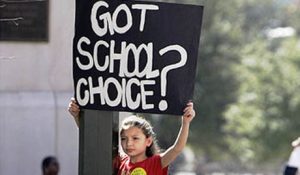While states across the nation plough forward with school choice initiatives that give families more freedom in how their children should be educated, Kansas seems occupied once again with how much more money to give school districts, many of which perpetually underperform, robbing students of adequate educational opportunities. Even in the higher performing schools, many students are still left behind.
While other states are promoting, passing, and expanding school choice – most of which through education savings/spending accounts, collectively known as ESA’s – Kansas politicians are dickering over how much more money to give to school districts to spend on special education.
In KPI’s most recent A-F Grading report card, we found that nearly half of all schools earned either a “D” or an “F” for 2023. For high schools only, nearly three-quarters received either a “D” or “F” as a grade. Special education students have an annual non-proficiency rate of about 90% on state assessments.
Though it seems intuitive that special education students should perform lower than other students, KSDE included “students with disabilities” as a subgroup in the approved state plan required by the federal Every Student Succeeds Act (ESSA). That means KSDE is on the hook for getting special education students to a 75% proficiency rate by 2032. That’s a steep climb from the current rate of about 10%. Guess what the education establishment’s answer is to this conundrum? If you said anything other than ‘more money’ you haven’t been paying attention.
But in the state legislature’s never-ending quest to satisfy public education’s insatiable monetary thirst at the taxpayers’ expense, the question is not whether to pony up more money, it’s how much. And, of course, the threat of a lawsuit is always on the horizon. Sound familiar? This has been going on for decades. Instead of allowing families a path that’s clear regarding education, ground zero is always “Is this enough money?” The last argument was over how much to give for at-risk funding. Check out Legislative Post Audit’s last two at-risk audits to see how that has worked out for Kansas students. Spoiler alert: hundreds of millions of dollars more, most of it not dedicated exclusively to non-at-risk students, no improvement in achievement.
To understand the miserable state of student achievement in Kansas, look no farther than Education Commissioner Randy Watson. The 2023 state assessment scores increased from 2022, an improvement that could be described as going from ‘woefully unacceptable’ to ‘not-quite-as-woefully unacceptable.’ In Watson’s animated presentation of that improvement to the State Board of Education, he claimed those results were worthy of doing a dance around the capitol.
Is it any wonder how poorly public schools in Kansas perform, and that it’s not getting any better?
Expansion of school choice in other states
While Kansas continues to wallow in appeasing the education establishment, other states have decided to focus on the concept of freedom of choice and improving outcomes for students. According to Forbes, ten states now have universal or near-universal private school choice, either in the form of education savings accounts, voucher programs, or tax credits: Arizona, Utah, Oklahoma, Iowa, Arkansas, Indiana, Ohio, Florida, West Virginia, and North Carolina.
The response in those states? Overwhelming.
Next up: A deeper dive into what other states are doing – and what Kansas should be doing – regarding parental choice.




